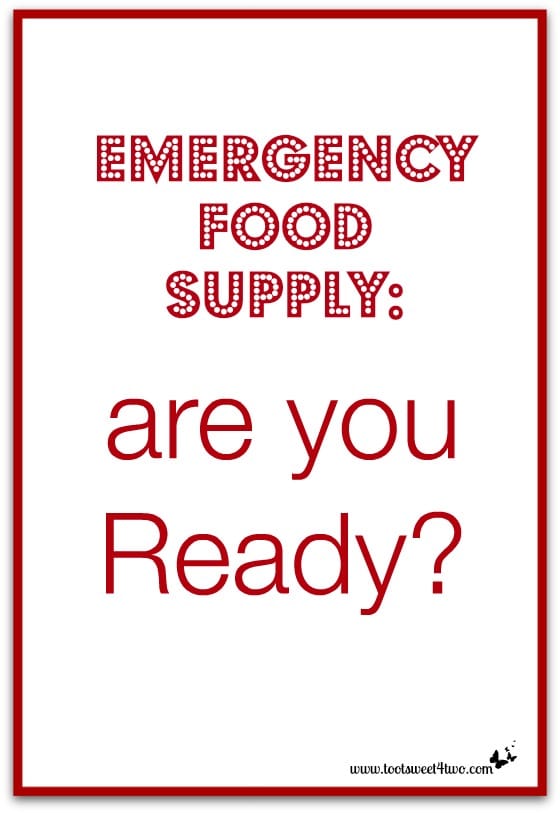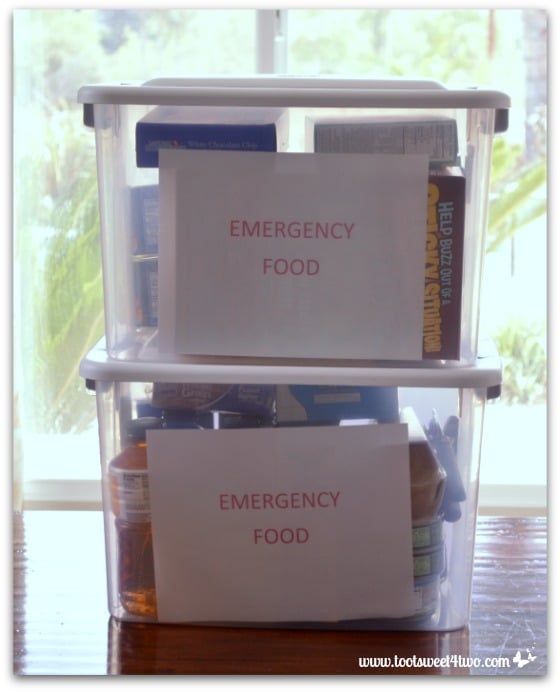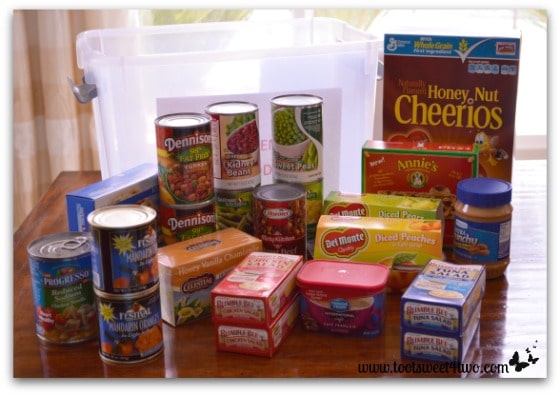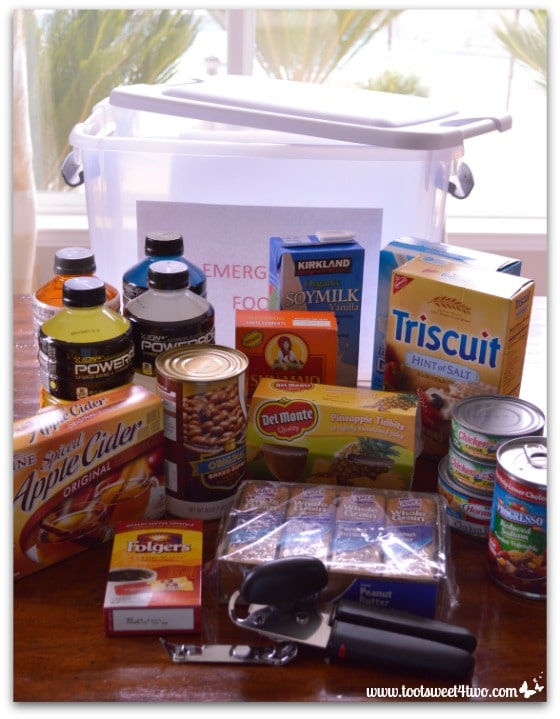
This may seem like an odd thing to say, but I really enjoy writing these monthly emergency planning posts. Why? Because they keep me moving forward! And, this post, Emergency Food Supply: are you Ready? does just that for me. Moves me forward.
Because just like most of you, I lead a “toot sweet” life and am easily distracted by the day-to-day business of living. And, when tackling a large project, such as emergency planning and preparedness, it is easy to lose steam, get off track or just give up!
If emergency planning and preparedness were easy, more people would do it! Did you know that more than half of Americans do not have an emergency plan in place? Not even a “mini plan”! That’s a staggering figure. It might be more – that number is based on people “surveyed”!
If you are a new reader of this series, welcome! If you are a regular follower, welcome back!
For new readers, I post monthly on emergency planning and preparedness because we lost our home in a wildfire in 2007 and we were not prepared. Not even a little.
While our “recovery” was hard, we did “recover”. Some people never recover from a catastrophic disaster. It is my hope by sharing our story with others online and doing these monthly posts, I can somehow (in a small way) help others move forward. As I write this post, major flash flooding is happening in the Phoenix, Arizona area and new wildfires are blazing near Yosemite National Park in California and somewhere around 30 fires (I can’t find an accurate count online!) are burning in California, Oregon, Washington, Idaho, Montana, Arizona, and Utah.
To all those affected by these latest disasters, my heart goes out to you.
If you’ve missed previous posts in this series, now’s your chance to catch up:
- Resolve to Be Ready 2014
- Blackout: are you Ready?
- Pet Owners: are you Ready?
- Evacuation: are you Ready?
- Alert: are you Ready?
- Water: are you Ready?
- Smoke Alarms: are you Ready? {Sponsored Post}
Before we get into the gist of this Emergency Food Supply: are you Ready? post, I have to share a funny story with you (I just have to!):
Charlie wakes up earlier than I do everyday and lets me sleep in a little bit longer. A creature of habit, he dresses and wheels himself (Charlie is handicapped and uses a mobility scooter) into our great room with our cat, Coco, leading the way and gets to work on his morning routine. He opens the curtains, one window for Coco to smell the fresh morning air, feeds Coco, makes coffee, turns on the TV and makes his breakfast – all before he comes to wake me.
A few weeks ago, I dragged myself out of bed (I’m not a morning person) and headed to the kitchen to get a cup of coffee. When I rounded the corner into the kitchen, I smelled smoke. I walked to the window, opened for Coco, and placed my face right up to the window screen and drew in a big sniff.
“Charlie, I smell smoke!”
“Oh, Carole,” Charlie sighed. “You are so paranoid. There is no smoke outside.”
“You come and sniff!”
“No, I’m not coming and sniffing. You are crazy!”
I walked back down the hallway to our bedroom. I did this because I hadn’t smelled the smoke until I came into the kitchen and I wanted to make sure I wasn’t crazy. Just in case. Because, really, I’m probably a little crazy, but I tell myself I’m “gun-shy” instead.
I smelled our bedroom; it smelled normal.
I walked back down the hallway towards the kitchen and the minute I rounded the corner, I smelled it again!
“I’m not crazy! I smell smoke. Do you think it’s the stove?” Our stove is powered by propane. I walked over to the stove and took a big sniff. It wasn’t the stove.
I walked back to the window and inhaled. It was definitely outside. I opened the patio door and walked outside to our backyard in my jammies. The smell was pervasive and I scanned the skies looking for evidence of fire. I walked back inside.
“Charlie, I definitely smell smoke outside. You need to come outside with me!”
“Carole, sometimes when the propane tank is low, it will start to emit a smell. It might be the propane tank. Let’s check.”
We both go outside together, this time through the garage. I walk towards the propane tank in my slippers and Charlie is not far behind.
“Carole!” he suddenly yells at me. I stop dead in my tracks, fearing the worse because of the fierce urgency of his voice, and turn around to face him.
“You’re a nut job! It’s a skunk!”
Sure enough, he was right. It was a skunk and my mind had decided it was smoke. Go figure! Anyway, I checked the propane tank (Charlie can’t get to it from his scooter) and it was fine.
I’m a wee bit crazy…
Okay; now for the gist of this post, Emergency Food Supply: are you Ready?:
Building an emergency food supply is expensive. Unless you are blessed financially and able to buy food supplies all at once, it will take time. Because, building an emergency food supply is two-fold:
- Emergency Evacuation Food Supply: needs to include enough food for 3 days for each person
- Shelter-in-Place Emergency Food Supply: needs to include enough food for 2 weeks for each person
There are kits available with freeze-dried food items that you can purchase for emergency use. However, I’m leery of anything with a super-long shelf life (I’m a migraine sufferer, sensitive to food additives)! So, I prefer to stock my shelves with foods that we normally would eat. But, those kits are available, should you choose to go that route.
Emergency Evacuation Food Supply
For my immediate family, there is just me and Charlie and, of course, our cat, Coco. So, our stash is small compared to a 4-person, 5-person, 6-person, etc. family. It’s all in two small plastic tubs in our pantry. Here are some pictures:



I have our emergency evacuation food supply in two small plastic tubs for two reasons:
- I need to be able to lift them because Charlie can’t
- And, they need to fit in our car along with all our other evacuation supplies.
Having an emergency evacuation food supply for a 6-person family is quite a lot of food! Hopefully, if you are such a family, you have a minimum of two cars at your disposal. In any case, whatever your family unit’s size is, that food needs to be manageable, i.e., it needs to be packed in such a way that one person can lift it.
Another great option, other than a small plastic tub, is a backpack. Do you buy your school age children a new backpack every few years? If so, repurposing an old backpack to use for your emergency evacuation food supply is a good use of an old item.
When building your emergency evacuation food supply, it’s a good idea to buy food that your family will eat. This is especially important if you have young children, because young children can be particularly picky! You’ll be under enough stress, as it is, without having to battle your children to eat what is on hand. So, to avoid further drama, pack things your family will eat.
So, what kinds of food should you pack? Here’s a list:
- Cereal (buy one with higher protein grams; this will keep you from getting hungry before lunch)
- Milk (buy “shelf” milk in the paper cartons); if you can find powdered milk, that’s good to have, too; but remember, it requires water to rehydrate it, so you will need to factor that in when building your emergency water supply!
- Canned fruits (since they are packed in juice, better for hydration purposes)
- Peanut butter
- Whole wheat crackers
- Trail mix and nuts (be sure to choose lower salt alternatives)
- Canned meats such as tuna, chicken, turkey
- Canned vegetables including beans (again, choose the lower salt variety)
- Granola bars and power bars
- Dried fruits such as raisins, cranberries
- Canned soup and chili (choose lower salt varieties)
- Gatorade or Powerade, coffee, tea, hot chocolate mixes
While not essential, having a few special non-perishable treats thrown in will lessen a stressful situation.
If you are building an emergency evacuation food supply from scratch, and don’t have the financial ability to do it all at once, add one or two items to your regular weekly grocery shopping list and build it over time. Having anything ready is better than having nothing at all. Be sure to keep your food supply in a cool, dry place easily accessible so that you can grab it in a hurry should the need arise.
Our emergency evacuation food supply is in our pantry. While not ideal, it is cool and dry. Our garage is not insulated, so it gets extremely hot in the summer months, not good for packaged food.
Also, be sure to check the expiration dates of your food supply on a regular basis (maybe with the change to daylight savings time) and rotate food near expiration into your meal planning to avoid waste. Be sure to replace items used on your next grocery shopping trip.
Finally, be sure to buy canned goods with pop-top lids or pack a manual can opener in with your emergency evacuation food supply. While you may have a can opener in another area of your emergency supply stash, if you forget to take those emergency supplies with you, you’ll be out of luck (and hungry!). And, don’t forget to add a supply of plastic eating utensils to your plastic tub or backpack.
Shelter-in-Place Emergency Food Supply
It is recommended that families have a 2 week supply of food for each person in the event of an emergency that requires you stay home, in place. For a 6-person family, that’s a lot of food! Here are some tips on how to manage this:
- Build your Emergency Evacuation Food Supply first. Once done, start on your Shelter-in-Place Emergency Food Supply.
- Build your supply over time. Add a few items to your weekly grocery shopping list.
- Create a space in your home (or garage or basement, if insulated) just for this purpose. Designate a specific closet or an area of your pantry, if you have a pantry. This will enable you to keep track of the size of your stash AND allow you to “rotate” your food in and out of your normal meal planning to avoid food waste as it nears its expiration date.
- Group like items together so that you can count/scan your supply easily to see what you are lacking.
- Create a menu with specific serving sizes so that your food lasts as long as possible.
What to include in your Shelter-in-Place Emergency Food Supply? All the items listed above in your Emergency Evacuation Food Supply, plus the following:
- Salt & pepper and other herbs and spices
- Rice and grains
- Dried beans
- Pasta and canned or bottled pasta sauces
- Salsas and other bottled flavorings
You may notice that I haven’t mentioned anything refrigerated or frozen. While it is likely you will have power in a Shelter-in-Place emergency situation, plan that you won’t. If you do have power, use those items first before using food in your emergency stash. Then, if you lose power over the course of your Shelter-in-Place emergency, you will have used some of your refrigerated/frozen food, thus less spoilage.
Speaking of losing power: invest in an outdoor barbecue grill. If powered by propane, make sure you have a propane source (such as a small tank) that is not fed by a utility company. If you have a charcoal grill, keep a supply of briquettes on hand.
I’ve created a couple of useful tools for you to print. Add these FREE printables to your Family Emergency Planning and Resources Binder:
- Emergency Planning Checklist (this leads you to a post with a checklist included)
- First Aid Kit Checklist (this leads you to a post with a checklist included)
- Resolve to Be Ready Project Checklist updated 8-20-2014
- Emergency Evacuation Food Supply Checklist
- Emergency Shelter-in-Place Food Supply Checklist
- Emergency Evacuation Meal Planning List
- Emergency Evacuation Food Supply Sample Menu
Start on this project today…now! Add a few items to your grocery shopping list this week and off you go!
Tootles,

Related Posts:
(other posts about emergency planning and preparedness)
Leave a Reply